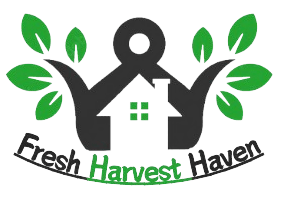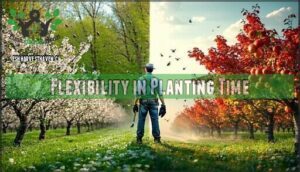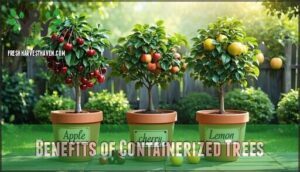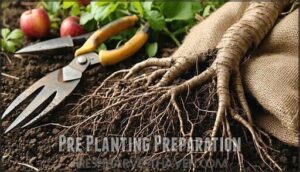This site is supported by our readers. We may earn a commission, at no cost to you, if you purchase through links.
 The best time to plant fruit trees is during their dormant season—late winter through early spring (February to April) or fall (October to November).
The best time to plant fruit trees is during their dormant season—late winter through early spring (February to April) or fall (October to November).
Spring planting works best in colder climates, giving trees a full growing season to establish roots before winter hits.
Fall planting suits milder regions, allowing root development during cool, moist conditions without the stress of supporting leaves and fruit.
Bare-root trees must be planted during dormancy, while containerized trees offer more flexibility year-round.
Your climate zone and tree type matter, but dormant season planting gives your trees the strongest foundation. There’s more to timing than just picking a season, though.
Table Of Contents
- Key Takeaways
- Best Planting Time
- Planting Bare Root Trees
- Containerized Tree Planting
- Pre Planting Preparation
- Post Planting Care
- Frequently Asked Questions (FAQs)
- What month is good to plant fruit trees?
- Is it better to plant fruit trees in the fall or spring?
- What is the easiest fruit tree to grow?
- What not to plant next to fruit trees?
- What month should fruit trees be planted?
- What month is best to plant fruits?
- Is it better to plant fruit trees in the spring or fall?
- What is the fastest fruit tree to plant?
- How far apart should fruit trees be planted?
- Can I graft fruit trees after planting?
- Conclusion
Key Takeaways
- Plant during dormant season (late winter through early spring) for the strongest root development and highest success rates
- Choose spring planting in colder climates after frost danger passes, or fall planting in warmer regions for better establishment
- You’ll get more flexibility with containerized trees since they can be planted throughout the growing season, unlike bare-root trees that need precise timing
- Prepare properly by inspecting root health, soaking bare-root trees before planting, and providing post-planting care including pest protection and winter monitoring
Best Planting Time
You’ll get the best results when you plant fruit trees during their dormant season, typically from late winter through early spring in most regions.
Plant during dormancy for maximum success—late winter through early spring delivers the strongest root systems.
Timing depends on your local climate zone, with colder areas favoring spring planting after the last hard frost and warmer regions often benefiting from fall planting, which can be considered as fall planting.
Early Spring Planting Benefits
For spring planting, you’ll maximize your fruit tree’s success through ideal timing.
Soil warming creates ideal conditions for root establishment while consistent moisture availability supports healthy bud development.
Here are four key spring planting benefits:
- Root Establishment – Trees develop strong root systems before summer heat
- Reduced Transplant Shock – Cooler temperatures minimize stress during establishment
- Soil Warming – Gradual temperature increases promote healthy growth
- Moisture Availability – Natural spring rains support new plantings
Fall Planting Considerations
Fall planting offers fruit trees a head start on root establishment before spring growth begins.
Cooler soil temperatures reduce transplant shock while autumn rains help with watering needs.
Trees enter their natural dormancy period, focusing energy on developing strong root systems.
Apply mulch benefits around newly planted trees to insulate roots through winter.
For reliable blooms, consider planting perennials like asters.
This timing works best in warmer climates where harsh freezes won’t damage young trees.
Regional Climate Factors
Your location’s Hardiness Zones and frost dates determine ideal fruit tree planting windows.
Northern regions favor early spring after soil temperature reaches 50°F, while southern areas allow winter planting.
Rainfall patterns affect timing—dry springs need irrigation, while heavy rains delay planting.
Sunlight exposure increases after last frost, supporting establishment, with Hardiness Zones and frost dates being crucial, and proper irrigation in dry conditions.
Planting Bare Root Trees
Bare root trees offer the best planting window when soil temperatures climb above 50°F but before summer heat arrives.
You’ll want to get them in the ground during late winter to early spring, typically 4-6 weeks before your last expected frost date.
Ideal Planting Period
You’ll achieve ideal planting success when soil temperature reaches 50°F and frost risk passes.
This typically occurs during your area’s hardiness zones’ recommended window. Monitor rainfall patterns to avoid waterlogged conditions.
Guarantee adequate sunlight exposure at your chosen site. Compost incorporation before planting boosts establishment rates substantially for your fruit trees.
Compost incorporation is a key step that can be considered a part of ensuring complete concepts are applied for better growth.
Avoiding Summer Planting
Summer planting creates hostile conditions for bare root fruit trees.
Summer heat and blazing sun spell disaster for vulnerable bare root plantings.
High temperatures trigger heat stress while intense sunlight causes root shock. Your newly planted trees face impossible watering needs as soil moisture evaporates rapidly.
Here’s why summer planting fails:
- Heat stress weakens root development and leaf production
- Sun damage scorches tender bark and developing foliage
- Excessive watering needs strain both tree and gardener resources
- Poor soil moisture retention prevents proper root establishment
Summer isn’t the best time to plant fruit trees – wait for cooler seasons when your efforts to plant fruit trees will succeed. To help mitigate these issues, consider using shade cloth effectively to protect new trees.
Winter Planting in Warmer Climates
Winter planting in warmer climates (USDA Zones 8-10) offers unique dormancy benefits when soil temperatures remain above 50°F.
Mild winters allow root establishment without frost damage, making this the best time to plant fruit trees in these regions.
Dormant planting reduces watering needs while trees develop strong root systems.
When to plant depends on your specific fruit tree season – typically December through February provides ideal conditions for successful establishment.
Containerized Tree Planting
Unlike bare root trees that require precise planting windows, containerized fruit trees offer you much more flexibility in timing.
You can plant them successfully from spring through fall, though each season presents distinct advantages for tree establishment and root development.
This flexibility, combined with the advantages of each season, makes containerized fruit trees a more versatile option for tree establishment.
Flexibility in Planting Time
Containerized fruit trees offer you unmatched flexibility in your planting schedule.
Unlike bare root varieties, these trees adapt to different planting windows throughout the growing season.
- Climate Adaptability allows planting across multiple seasons in most regions
- Microclimate Influence lets you time plantings based on specific yard conditions
- Species Variation means different fruit trees have unique preferred planting periods
- Delayed Planting becomes possible when spring weather doesn’t cooperate
- Weather Windows can be utilized whenever soil conditions are workable
Benefits of Containerized Trees
Containerized fruit trees offer significant advantages over bare-root options.
You’ll get Rootball Protection that keeps roots moist and healthy during transport.
These trees provide an Extended Season for planting since roots stay protected in soil.
Easier Handling means less mess and simpler transportation to your planting site.
Reduced Shock occurs because roots remain undisturbed, leading to Higher Success rates for establishing your fruit trees.
Planting Containerized Trees in Fall
Fall offers unique advantages for planting containerized fruit trees.
You’ll tap into extended root development time before winter dormancy hits.
The cooler temperatures reduce transplant stress while soil moisture stays more consistent.
Check for rootbound solutions by gently loosening compacted roots.
Reduce watering needs as evaporation drops substantially.
Apply mulching benefits around the base for winter protection and soil warmth retention, which also supports extended root development.
Pre Planting Preparation
Before you plant your fruit trees, you’ll need to check their condition and prepare them properly.
This essential step determines whether your trees will thrive or struggle in their new home.
Tree Inspection and Storage
Every successful planting fruit trees project starts with thorough Root Inspection and proper Storage Methods before you dig. Smart gardeners know that checking your trees ahead of time prevents costly mistakes and guarantees better survival rates.
- Examine roots for damage, rot, or circling patterns that indicate poor nursery practices
- Store bare-root trees in cool, humid conditions with roots wrapped in damp burlap
- Check Hydration Levels by gently squeezing roots – they should feel firm, not mushy
- Implement Pest Prevention by inspecting for insect eggs, fungal growth, or unusual discoloration
Proper Damage Assessment now saves headaches later. Consider using specialized root examination equipment for a more detailed analysis. Keep containerized fruit tree varieties in partial shade until planting, and never let roots dry out during storage.
Root Health and Moisture
After inspecting your tree, check the roots carefully.
Healthy roots appear white or cream-colored with firm texture.
Dark, mushy roots indicate root rot from poor soil drainage.
If root rot is present, consider specialized root rot solutions.
Soak bare-root trees in water for 6-12 hours before the best time plant arrives.
Well-draining soil prevents waterlogged conditions that harm mycorrhizal fungi and reduce oxygen levels, ensuring ideal planting conditions for fruit tree care success.
Treating Crown Gall Disease
Before planting, inspect your fruit trees for crown gall disease through careful gall identification around the crown and roots.
Remove infected trees immediately using proper pruning techniques to prevent spread. Consider soil sterilization in heavily affected areas and select resistant varieties when possible.
Apply antibacterial treatments like Agrobacterium radiobacter strain K84 during planting for effective tree care.
Early detection is key, as visual diagnosis is easier when symptoms are recognized early, allowing for effective tree care.
Post Planting Care
Once you’ve planted your fruit tree, your work isn’t finished. Proper post-planting care determines whether your tree thrives or struggles during its critical first year.
Monitoring for Winter Damage
After securing your newly planted trees, winter conditions can reveal unexpected challenges that require prompt attention.
Check your fruit trees monthly during cold months for these warning signs:
- Identifying Damage – Look for bark splits, broken branches, or discolored tissue
- Sunscald Prevention – Wrap trunks with white tree guards to reflect harsh winter sun
- Frost Cracks – Inspect for vertical bark splits on south-facing trunk sides
- Snow Damage – Remove heavy snow loads from branches to prevent breakage
Different fruit tree types show varying vulnerability to winter stress, making regular monitoring part of your tree planting guide essentials.
Protecting Trees From Pests
After planting, you’ll need to shield your young trees from various threats that can derail their growth.
Hardware cloth around trunks prevents rodent damage, while white latex paint deters boring insects.
Apply sticky bands to trap crawling pests and use beneficial insects for natural predators.
Many gardeners also use hardware cloth tree guards for added protection.
Monitor regularly for pest identification and apply organic solutions before resorting to chemical treatments as preventative measures.
Pruning and Training Young Trees
Beyond protecting your newly planted trees, proper pruning sets the foundation for years of healthy growth.
Start initial pruning immediately after planting to establish a strong central leader system. Select three to four well-spaced scaffold branches, removing competing limbs and weak growth.
These training systems create the tree’s basic structure. Follow your regional planting guidelines and tree care guide recommendations for timing.
This early branch selection determines your tree’s future productivity and strength. To encourage better growth, remember to remove any dead wood.
Frequently Asked Questions (FAQs)
What month is good to plant fruit trees?
March through May delivers your golden window for planting fruit trees.
You’ll dodge harsh winter damage while giving roots time to establish before summer’s scorching heat hits.
Plant after frost danger passes but before temperatures soar, ensuring your trees have the best chance to thrive in the scorching heat.
Is it better to plant fruit trees in the fall or spring?
Cold climates favor spring planting after frost danger passes, while warm regions benefit from fall planting. You’ll get better root establishment when soil temperatures stay above 50°F consistently.
What is the easiest fruit tree to grow?
Apple trees practically grow themselves, making them perfect for beginners.
You’ll find varieties like Honeycrisp and Gala are incredibly forgiving, thriving in most climates with minimal fuss and producing sweet rewards within just a few years.
What not to plant next to fruit trees?
Don’t plant black walnut trees, which release toxins that stunt growth.
Avoid large shade trees that’ll compete for sunlight and nutrients.
Skip aggressive spreaders like mint or bamboo that’ll overwhelm roots.
What month should fruit trees be planted?
Like timing the perfect pitch, you’ll want to plant bare-root fruit trees in late winter through early spring.
March through April works best in cold climates, while warm regions favor fall planting for ideal establishment.
What month is best to plant fruits?
February through April offers ideal planting windows for most climates.
You’ll want to plant after frost danger passes but before summer heat arrives.
Fall planting works well in warmer zones, giving roots time to establish before spring growth begins, with ideal planting and warmer zones being key considerations.
Is it better to plant fruit trees in the spring or fall?
Ironically, timing’s everything when you’re racing against Mother Nature’s clock.
Spring planting works best in cold climates (zones 3-7) after frost danger passes, while fall suits warm regions (zones 8-10) perfectly for root establishment.
What is the fastest fruit tree to plant?
Fast-growing dwarf varieties like dwarf cherry or dwarf apple trees reach maturity quickest, producing fruit within 2-3 years. You’ll get faster harvests compared to standard-sized trees that take 5-7 years.
How far apart should fruit trees be planted?
Proper spacing prevents overcrowding and disease spread.
You’ll want 15-25 feet between standard trees, 8-12 feet for semi-dwarf varieties, and 6-8 feet for dwarf trees, depending on species and mature size.
Can I graft fruit trees after planting?
Yes, you can graft fruit trees after planting.
Wait until trees establish strong root systems, typically one to two years.
Spring’s the best time when sap flows actively, ensuring successful graft union formation.
Conclusion
Sure, you’ve mastered the art of procrastination and now your fruit trees are judging you from their containers.
The best time to plant fruit trees isn’t rocket science—dormant season wins every time.
Spring planting suits colder regions, while fall works in milder climates.
Whether you choose bare-root or containerized trees, proper timing gives your future orchard the strongest start.
Stop overthinking and start digging during dormancy for maximum success.











